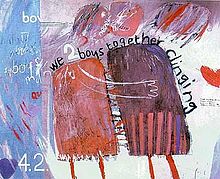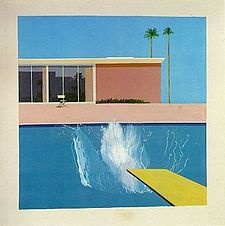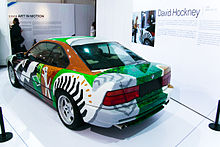- David Hockney
-
David Hockney 
We Two Boys Together Clinging (1961)Born 9 July 1937
Bradford, EnglandNationality English Field Painting, Printmaking, Photography, Set design Training Bradford School of Art (1953–1957)
Royal College of Art (1959–1962)Movement Pop art Awards John Moores Painting Prize (1967)
Companion of Honour (1997)
Royal AcademicianDavid Hockney, CH, RA, (born 9 July 1937) is an English painter, draughtsman, printmaker, stage designer and photographer, who is based in Bridlington, Yorkshire and Kensington, London.[1]
An important contributor to the Pop art movement of the 1960s, he is considered one of the most influential British artists of the twentieth century.[2]
Contents
Life
Hockney was born in Bradford, England on 9 July 1937 to Laura and Kenneth Hockney and was educated first at Wellington Primary School then Bradford Grammar School, Bradford College of Art and the Royal College of Art in London, where he met R. B. Kitaj. While he was there Hockney said he felt at home, he took pride and success in his work here. While a student at the Royal College of Art, Hockney was featured in the exhibition Young Contemporaries—alongside Peter Blake—that announced the arrival of British Pop art. He was associated with the movement, but his early works also display expressionist elements, not dissimilar to certain works by Francis Bacon. Sometimes, as in We Two Boys Together Clinging (1961), named after a poem by Walt Whitman, these works make reference to his love for men. From 1963, Hockney was represented by the art dealer John Kasmin. In 1963 Hockney visited New York, making contact with Andy Warhol. A subsequent visit to California, where he lived for many years, inspired Hockney to make a series of paintings of swimming pools in Los Angeles, using the comparatively new acrylic medium and rendered in a highly realistic style using vibrant colours. In 1967, his painting, Peter Getting Out Of Nick's Pool, won the John Moores Painting Prize at the Walker Art Gallery in Liverpool. He made prints, portraits of friends, and stage designs for the Royal Court Theatre, Glyndebourne, La Scala and the Metropolitan Opera in New York City.
Hockney's older sister, Margaret, who lives in Yorkshire, is an artist of still life photos.
Hockney was born with synesthesia; he sees synesthetic colours to musical stimuli. In general, this does not show up in his painting or photography artwork too much. However, it is a common underlying principle in his construction of stage sets for various ballets and operas, where he bases the background colours and lighting upon his own seen colours while listening to the music of the theatre piece he is working on.
Works
The "joiners"
David Hockney has also worked with photography, or, more precisely, photocollage. Using varying numbers of small Polaroid snaps or photolab-prints of a single subject Hockney arranged a patchwork to make a composite image. One of his first photomontages was of his mother. Because these photographs are taken from different perspectives and at slightly different times, the result is work that has an affinity with Cubism, which was one of Hockney's major aims—discussing the way human vision works. Some of these pieces are landscapes such as Pearblossom Highway #2,[2][3] others being portraits, e.g. Kasmin 1982,[4] and My Mother, Bolton Abbey, 1982.[5]
Hockney created these photomontage works mostly between 1970 and 1986. He referred to them as "joiners".[6] He began this style of art by taking Polaroid photographs of one subject and arranging them into a grid layout. The subject would actually move while being photographed so that the piece would show the movements of the subject seen from the photographer's perspective. In later works Hockney changed his technique and moved the camera around the subject instead.
Hockney's creation of the "joiners" occurred accidentally. He noticed in the late sixties that photographers were using cameras with wide-angle lenses to take pictures. He did not like such photographs because they always came out somewhat distorted. He was working on a painting of a living room and terrace in Los Angeles. He took Polaroid shots of the living room and glued them together, not intending for them to be a composition on their own. Upon looking at the final composition, he realized it created a narrative, as if the viewer was moving through the room. He began to work more and more with photography after this discovery and even stopped painting for a period of time to exclusively pursue this new style of photography. Frustrated with the limitations of photography and its 'one eyed' approach,[7] he later returned to painting.
Later works
 A Bigger Splash, 1967, Tate Collection, London.
A Bigger Splash, 1967, Tate Collection, London.
In 1974, Hockney was the subject of Jack Hazan's film, A Bigger Splash (named after one of Hockney's swimming pool paintings from 1967).
In 1977 David Hockney authored a book of etchings called The Blue Guitar: Etchings By David Hockney Who Was Inspired By Wallace Stevens Who Was Inspired By Pablo Picasso. The etchings were inspired by and represented the themes of Stevens' poem, "The Man With The Blue Guitar", which accompanied the art. It was published as a portfolio and as a book in spring 1997 by Petersburg Press.[8]
Hockney was commissioned to design the cover and a series of pages for the December 1985 issue of the French edition of Vogue. Consistent with his interest in cubism and admiration for Pablo Picasso, Hockney chose to paint Celia Birtwell (who appears in several of his works) from different views, as if the eye had scanned her face diagonally.
In December 1985, Hockney was commissioned to draw with the Quantel Paintbox, a computer program that allowed the artist to sketch directly onto the screen. Using this program was similar to drawing on the PET film for prints, with which he'd had much experience. The resulting work was featured in a BBC series profiling a number of artists.
His artwork was used on the front cover of the 1989 British Telecom telephone directory for Bradford.
 A Bigger Grand Canyon, 1998, National Gallery of Australia.
A Bigger Grand Canyon, 1998, National Gallery of Australia.
His A Bigger Grand Canyon, a series of 60 paintings that combined to produce one enormous picture, was bought by the National Gallery of Australia for $4.6 million.
On 21 June 2006, his painting of The Splash fetched £2.6 million - a record for a Hockney painting.[9]
In October 2006 the National Portrait Gallery in London organized one of the largest ever displays of Hockney's portraiture work, including 150 of his paintings, drawings, prints, sketchbooks and photocollages from over five decades. The collection ranged from his earliest self-portraits to work completed in 2005.[10] Hockney himself assisted in displaying the works, and the exhibition, which ran until January 2007, proved to be one of the most successful in the gallery's history.
In June 2007, Hockney's largest painting, Bigger Trees Near Warter, which measures 15x40', was hung in the Royal Academy's largest gallery in their annual Summer Exhibition.[11] This work "is a monumental-scale view of a coppice in Hockney's native Yorkshire, between Bridlington and York. It was painted on 50 individual canvases, mostly working in situ, over five weeks last winter."[12] In 2008, he donated this work to the Tate Gallery in London, saying: "I thought if I'm going to give something to the Tate I want to give them something really good. It's going to be here for a while. I don't want to give things I'm not too proud of...I thought this was a good painting because it's of England...it seems like a good thing to do".[13]
Since 2009, Hockney has painted hundreds of portraits, still lifes and landscapes using the Brushes iPhone[14] and iPad[15] application, often sending them to his friends.[15]His show Fleurs fraîches (Fresh Flowers) just closed at La Fondation Pierre Bergé in Paris. A Fresh-Flowers exhibit opened in 2011 at the Royal Ontario Museum in Toronto, featuring over 100 of Hockney's drawings on 25 iPads and 20 iPods.[16]
Many of Hockney's works are now housed in Salts Mill, in Saltaire, near his home town of Bradford.
The Hockney-Falco thesis
Main article: Hockney–Falco thesisIn the 2001 television programme and book, Secret Knowledge, Hockney posited that the Old Masters used camera obscura techniques, utilized with a concave mirror, which allowed the image of the subject to be projected onto the surface of the painting. Hockney argues that this technique migrated gradually to Italy and most of Europe, and is the reason for the photographic style of painting we see in the Renaissance and later periods of art.
Public life
A conscientious objector, Hockney worked as a medical orderly in hospitals as his National Service 1957–59.[citation needed]
He was made a Companion of Honour in 1997 and is also a Royal Academician.[citation needed]
Hockney was offered a knighthood in 1990, but he declined the offer.[citation needed]
Hockney serves on the advisory board of the political magazine Standpoint,[17] and contributed original sketches for its launch edition, in June 2008.[18]
He is a staunch pro-tobacco campaigner and was invited to guest-edit the Today programme on 29 December 2009 to air his views on the subject.[19]
In October 2010 he and 100 other leading artists signed an open letter to the Secretary of State for Culture, Media and Sport, Jeremy Hunt protesting against cutbacks in the arts.[20]
In popular culture
David Hockney was the inspiration of artist Billy Pappas in the documentary film Waiting for Hockney, which debuted at the Tribeca Film Festival in 2008.[21]
See also
References
- ^ Karen Wright,"Brushes with Hockney," Intelligent Life, Summer 2010, retrieved, 8-19-11.
- ^ a b J. Paul Getty Museum. David Hockney. Retrieved 13 September 2008.
- ^ Image of Pearblossom Highway
- ^ Image of Kasmin 1982
- ^ Image of photocollage My Mother, Bolton Abbey, 1982
- ^ Hockney on Photography: Conversations with Paul Joyce (1988) ISBN 0224024841
- ^ Hockney on Art - Paul Joyce ISBN 140870157X
- ^ Amazon.com: The Blue Guitar: Etchings By David Hockney Who Was Inspired By Wallace Stevens Who Was Inspired By Pablo Picasso
- ^ Hockney painting sells for £2.6m
- ^ Meredith Etherington-Smith (15 August 2006). "A David Hockney Moment". ARTINFO. http://www.artinfo.com/news/story/19262/a-david-hockney-moment/. Retrieved 17 April 2008.
- ^ Bigger Trees near Warter as seen in the Royal Academy, June 2007
- ^ Charlotte Higgins, Hockney's big gift to the Tate: a 40ft landscape of Yorkshire's winter trees, The Guardian, 8 April 2008 [1]
- ^ Simon Crerar "David Hockney donates Bigger Trees Near Warter to Tate", The Times, 7 April 2008.
- ^ Lawrence Weschler, "David Hockney's iPhone Passion, The New York Review of Books, 22 October 2009
- ^ a b Gayford, Martin. "David Hockney’s IPad Doodles Resemble High-Tech Stained Glass" Bloomberg, 26 April 2010.
- ^ Katz, Brigit (21 November 2011). "Freshly pressed". The Varsity. http://thevarsity.ca/articles/49917. Retrieved 21 November 2011.
- ^ Standpoint staff (2009). "Standpoint Advisory Board". Social Affairs Unit Magazines. http://www.standpointmag.co.uk/about-us.
- ^ Standpoint staff (2008). "David Hockney - Exclusive sketches for his new Tate masterpiece". Social Affairs Unit Magazines Ltd. http://standpointmag.co.uk/magazine/26.
- ^ BBC press office (2009). "Radio 4's Today announces this year's guest editors". BBC. http://www.bbc.co.uk/pressoffice/pressreleases/stories/2009/12_december/10/today.shtml.
- ^ Peter Walker, "Turner prize winners lead protest against arts cutbacks," The Guardian, 1 October 2010.
- ^ IMDB, "Waiting for Hockney (2008)"
External links
- Hockneypictures.com Official website
- Biography page at LA Louver gallery Example of work from the 60s to the present
- DavidHockney.com tribute site
- Salts Mill in Saltaire, Yorkshire, England, contains a permanent exhibition of Hockney's work.
- David Hockney visits own exhibition at Nottingham Contemporary [BBC Nottingham]
- David Hockney on 'A Bigger Splash' [BBC Nottingham]
- Interview with David Hockney Nov 2009 [BBC Nottingham]
- Peter Getting Out Of Nick's Pool (1966) at The Walker Art Gallery, Liverpool, UK
- New Yorker discussion of Hockney's suggestion that the Old Masters used optical devices to aid drawing
- Hockney leads smoking ban protest BBC article.
- Jonathan Jones, Cooler than Warhol, more enduring than Freud (Interview), The Guardian, 8 September 2006
- A A Gill, The Turner Surprise: David Hockney on Turner, The Times, 17 June 2007
- David Hockney, The Fallen Beech Trees and the Lost Canvas, The Guardian, 27 March 2009
- David Hockney's Long Road From Los Angeles to Yorkshire, The New York Times, 15 October 2009
- David Hockney: Portrait of the Old Master, Tim Adams, The Guardian and Observer, 1 November 2009
- Annely Juda Fine Art, contemporary London art gallery that represents David Hockney
- "David Hockney: A man aflame – and long before the smoking ban" Michael Church, The Independent, 8 August 2010
School of London Michael Andrews · Frank Auerbach · Francis Bacon · Lucian Freud · David Hockney · Howard Hodgkin · R. B. Kitaj · Leon Kossoff · Patrick Swift
Categories:- 1937 births
- Living people
- Academics of the University for the Creative Arts
- Alumni of the Royal College of Art
- Artist authors
- Artists from California
- British conscientious objectors
- Contemporary painters
- English painters
- English photographers
- Gay artists
- LGBT people from England
- Art in the Greater Los Angeles Area
- Members of the Order of the Companions of Honour
- Old Bradfordians
- Opera designers
- People from Bradford
- Pop artists
- Postmodern artists
- Royal Academicians
- Alumni of Chelsea College of Art & Design
- People with synesthesia
Wikimedia Foundation. 2010.

